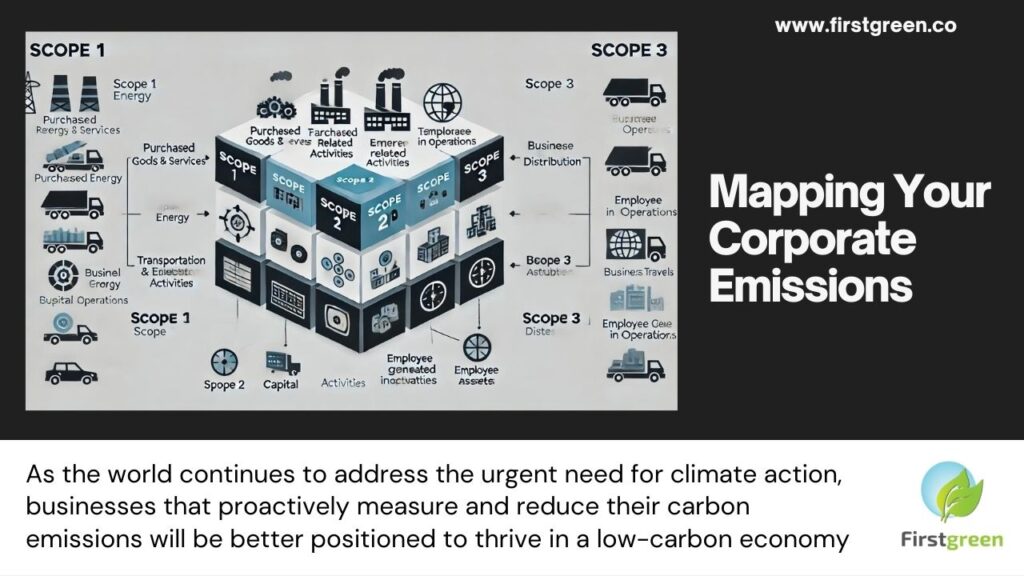Mapping Your Corporate Emissions

The Greenhouse Gas Protocol: Your Roadmap for Emissions Measurement
When it comes to measuring your carbon footprint, the Greenhouse Gas (GHG) Protocol stands out as the industry standard. This protocol is reporting framework agnostic, meaning it can be used regardless of the specific sustainability framework your organization follows. Whether your focus is on the Sustainable Development Goals (SDGs), the guidelines of the World Economic Forum, or the Task Force on Climate-related Financial Disclosures (TCFD), the GHG Protocol provides a robust foundation for calculating your emissions.
The GHG Protocol emphasizes five key principles: relevance, completeness, consistency, transparency, and accuracy. These principles ensure that your emissions calculations are both meaningful and reliable. Once you’ve established your baseline emissions, you can develop and implement a strategy to reduce them, ultimately improving your overall carbon footprint.
Mapping Your Emissions: Understanding Scope 1, 2, and 3
To effectively manage your carbon emissions, it’s essential to understand the different categories under the GHG Protocol:
- Scope 1: Direct emissions from sources that are owned or controlled by your company, such as fuel combustion in company-owned vehicles or equipment.
- Scope 2: Indirect emissions from the consumption of purchased electricity, which accounts for the energy consumed by your company.
- Scope 3: Indirect emissions that occur in your value chain, both upstream and downstream. These include emissions from purchased goods and services, transportation, waste disposal, and even the use of sold products.
Mapping Corporate Emissions:
- Scope 1: Includes emissions from stationary combustion (e.g., boilers), mobile combustion (e.g., company vehicles), and fugitive emissions (e.g., refrigerants).
- Scope 2: Focuses on purchased electricity, which can be measured using either market-based data (specific to your energy provider) or location-based data (based on the average emissions factor of your region).
- Scope 3: Encompasses a wide range of activities, including purchased goods and services, transportation and distribution, waste generated in operations, business travel, employee commuting, and the end-of-life treatment of sold products.
Overcoming Challenges in Emissions Measurement
At Firstgreen Consulting, we understand that measuring your corporate emissions can be challenging, particularly when it comes to data availability and quality—especially for Scope 3 emissions. Companies often face difficulties in obtaining accurate data from their suppliers or in tracking emissions across complex value chains. However, these challenges should not deter you from starting the process.
To overcome these challenges, we recommend the following strategies:
- Supplier Engagement: Work closely with your suppliers to obtain accurate data on their emissions, which will improve the accuracy of your Scope 3 calculations.
- Invest in Technology: Utilize advanced data collection and management tools to streamline the process of gathering and analyzing emissions data.
- Focus on High-Impact Areas: Identify the most significant sources of emissions within your organization, such as business travel or energy consumption, and develop targeted reduction strategies.
From Measurement to Action: Reducing Your Carbon Footprint
Once you have mapped your emissions and established a baseline, the next step is to reduce your carbon footprint. This involves a hierarchical approach:
- Avoid: The most effective way to reduce your carbon footprint is to avoid activities that generate emissions altogether, such as minimizing unnecessary business travel.
- Reduce: Implement energy-efficient technologies and processes to lower emissions where avoidance is not possible.
- Restore: Invest in renewable energy sources and other carbon reduction initiatives to counteract unavoidable emissions.
- Offset: Purchase carbon offsets to neutralize any remaining emissions and achieve your net-zero goals.
Conclusion
Mapping and reducing your corporate emissions is a critical component of any comprehensive sustainability strategy. By following the GHG Protocol and leveraging the expertise of Firstgreen Consulting, you can establish a clear emissions baseline, identify opportunities for improvement, and take meaningful action to reduce your carbon footprint. As the global economy continues to shift towards sustainability, companies that prioritize these efforts will not only contribute to climate goals but also secure a competitive advantage in the marketplace.
At Firstgreen Consulting, we are here to guide you every step of the way, helping you achieve your sustainability objectives and build a greener future.